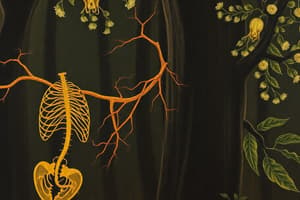Podcast
Questions and Answers
What is another term for the sympathetic division in the nervous system?
What is another term for the sympathetic division in the nervous system?
- Thoracolumbar division (correct)
- Cervical division
- Coccygeal division
- Sacral division
Which division of the autonomic nervous system is referred to as the thoracolumbar division?
Which division of the autonomic nervous system is referred to as the thoracolumbar division?
- Somatic division
- Parasympathetic division
- Enteric division
- Sympathetic division (correct)
What anatomical region is associated with the sympathetic division?
What anatomical region is associated with the sympathetic division?
- Thoracic and lumbar (correct)
- Coccygeal
- Cervical
- Sacral
The term 'thoracolumbar' refers to which of the following?
The term 'thoracolumbar' refers to which of the following?
Which of the following divisions is NOT associated with the term sympathetic?
Which of the following divisions is NOT associated with the term sympathetic?
Flashcards are hidden until you start studying
Study Notes
Autonomic Nervous System
- The autonomic nervous system (ANS) has two divisions: sympathetic and parasympathetic.
- The sympathetic nervous system is also called the thoracolumbar division.
- The parasympathetic nervous system is also called the craniosacral division.
Anatomical Differences between the Sympathetic and Parasympathetic Divisions
- The preganglionic fibers of the sympathetic nervous system are short.
- The preganglionic fibers of the parasympathetic nervous system are long.
- The postganglionic fibers of the sympathetic nervous system are long.
- The postganglionic fibers of the parasympathetic nervous system are short.
Functional differences between the Sympathetic and Parasympathetic Nervous Systems
- The sympathetic nervous system is responsible for the "fight or flight" response.
- The parasympathetic nervous system is responsible for the "rest and digest" response.
### Neurotransmitter release
- The preganglionic axons of both branches release acetylcholine.
- The postganglionic axons of the sympathetic nervous system mainly release norepinephrine.
- The postganglionic axons of the parasympathetic nervous system release acetylcholine.
Receptors involved in parasympathetic nervous system
- Nicotinic Receptors:
- Stimulate all autonomic ganglia.
- Secretion of norepinephrine and epinephrine from the suprarenal gland.
- Skeletal muscle contraction.
- Muscarinic Receptors:
- Increase HCl secretion in the stomach.
- Decrease heart rate (negative chronotropy).
- Slow heart conductivity (negative dromotropy).
- Decrease atrial contraction (negative inotropic effect).
- Bronchoconstriction and increase bronchial secretion in the respiratory tract.
- Increase secretion of glands (salivation, sweating, lacrimation, etc.).
- Contraction of the urinary bladder wall and relaxation of the ureter and sphincters of the urinary tract.
- Increase intestinal motility and secretion, and relax sphincters.
- Accommodation to near vision.
### Acetylcholine
- Acetylcholine is a neurotransmitter that is rapidly hydrolyzed by neuronal acetylcholinesterase and plasma butyrylcholinesterase.
- Acetylcholine is the primary transmitter in postganglionic sympathetic and parasympathetic nerves, thermoregulatory sweat glands, and neuromuscular junctions.
Studying That Suits You
Use AI to generate personalized quizzes and flashcards to suit your learning preferences.



